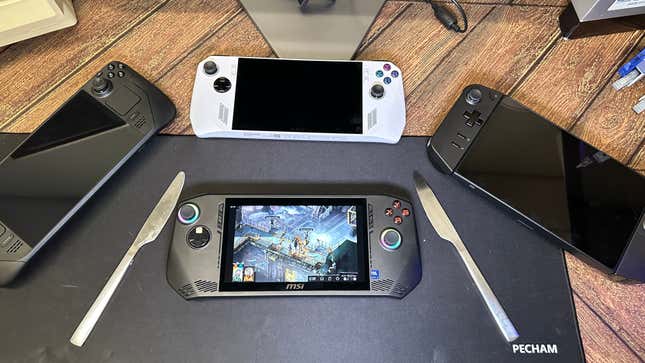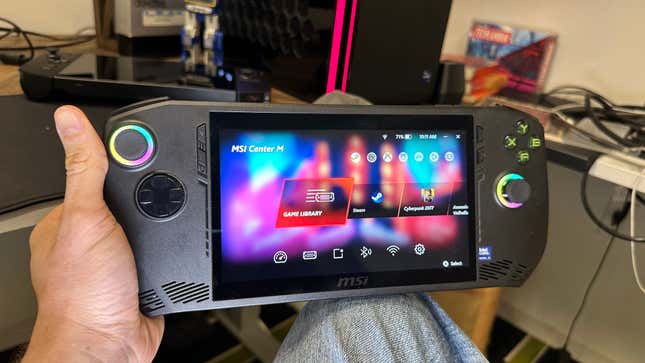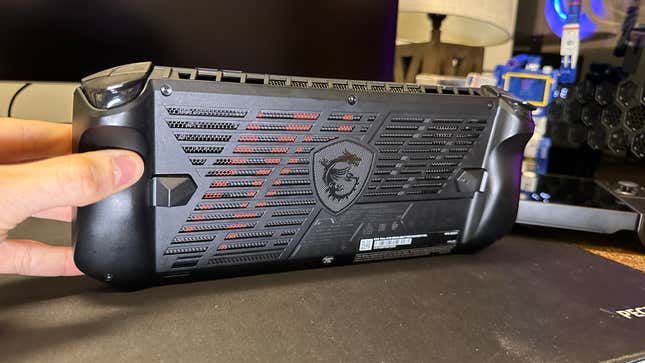MSI Claw A1M
The MSI Claw can’t compete with the other major handhelds on the market, even with significant performance updates.
The MSI Claw is too expensive for this kind of performance, and the half-baked software does little to mask the issues present with Windows on a handheld. Unless you find the Claw with a heavy discount for less than you can get other gaming handhelds, it’s best to wait until the sequel Claw comes out later this year.
Starting at $750 for the Intel Core Ultra 7 model (Reviewed at $800 for the 1 TB version)
Pros
RGB Lighting in the face buttons
Latest updates and Overboost greatly enhance overall performance
Cons
Center M software is obtuse and annoying
Battery life is middling at best
It costs too damn much for what you get
The MSI Claw A1M didn’t need to do much to be a contender in the still nascent gaming handheld PC space. If MSI had crafted the budget option, the lower-end device with fewer bells and whistles than its competitors, it would be a solid buy. Unfortunately for everyone involved, MSI made one of the more expensive renditions of the current Linux- or Windows-based gaming handhelds, and yet it somehow feels like the cheapest and least thought-out of what’s released so far.
Even MSI seems to have acknowledged it missed the mark, and now it has a new, updated console coming out sometime soon. In my experience, performance was fair. All of which seems to scream: don’t buy this console—or at the very least don’t not without some kind of hefty discount.
The two versions of the Claw that cost more than $700 are packing an Intel Core Ultra 7-155H chip. Over the past few months, I’ve had a great deal of experience with the Ultra 7 mobile chip, and I thought I had a better idea of how it would perform in a handheld. MSI promised that after the latest updates, the Claw should be getting better performance than the ROG Ally in several different titles, ostensibly enough to justify its higher cost.
But nothing does. MSI Claw has RGB lighting in both the thumbsticks and the buttons, and it looks nice. Does it drain the battery? Yes, technically, but it’s there for those of us who want it. That’s quite literally the one thing I would say the Claw has that other major gaming handhelds don’t.
The big question is how low in price the MSI Claw needs to go before it’s worth picking up. The $700 Lenovo Legion Go (with 1 TB of storage) and $650 ROG Ally with the AMD Ryzen Z1 Extreme (max 512 GB of storage) are far better buys. The MSI Claw would have to drop prestigiously before I’d consider it a real option. Then there’s the Steam Deck OLED, which is my current console of choice. You can grab the 1 TB version for $650 MSRP. The less powerful Claw with an Intel Core Ultra 5 chip is a mind-boggling $700 MSRP, and I have a feeling it won’t match the performance of the other major brands.
Perhaps there’ll be a discount once MSI releases its new console. You heard that right. MSI says it’s already working on an 8-inch semi-sequel called the MSI Claw 8 AI. The company said in a release that it “listened to user feedback, “ so the new console is supposed to have one of the upcoming, more powerful Intel Lunar Lake processors. The new console will have a battery and Thunderbolt 4 support, and the right and left bumpers should be changed so they feel less spongey. In addition, MSI’s director of product management, Clifford Chun, mentioned earlier this month they’re also working on a new 7-inch version.
If the Claw 8 also manages to match the battery and performance of the ROG Ally X, fixes up the control issues, and updates the software without adjusting the price, maybe it will be a contender.
For all its promise, the first Claw is not, and likely never will be.
MSI Claw Design and Software
Everything Needs a Heavy Facelift Three Months After Release
The MSI Claw looks so much like a ROG Ally that it’s uncanny. There are only subtle differences, but they greatly affect overall comfort. The face buttons and d-pad are just fine, maybe even a little more pronounced than the Ally or the Legion Go, but the thumb sticks get the worst of it. I didn’t like the tiny, toothpick-thin feel of the sticks on the Legion Go or the Ally, and these aren’t any better. They’re Hall Effect joysticks that should make them last for a long time, but they have so little resistance and lack the tactile feel I demand for such an expensive device.
The triggers are fine, but the bumper buttons are some of the worst I’ve used on a modern controller. They feel spongey and only collapse toward the edges rather than press down uniformly. The two back bumpers have enough click to them, but the way the rear shell was designed makes it difficult to reach behind to press them.
The Claw doesn’t really feel like it’s meant for an adult’s hands. I’d imagine some alien creature whose lead fingers are twice as long as their pinkies (maybe that’s why it’s named “The Claw”). My fingers naturally want to curl around some part of the rear chassis, but it’s so jagged and un-ergonomic that I could never get a comfortable grip. A large fan grate section runs along the back of the shell, and inevitably, your fingers will dance upon one groove or another. Yes, the tips of your fingers do start to feel slightly warmer than the rest of your hand during a long gaming session.
This is another Windows handheld machine, and with that comes all the baggage of an OS made for bigger screens. Microsoft’s refusal to release a version of their OS specific to handhelds has forced OEMs to come up with their own solution. Like the Ally and Legion Go, the Claw comes with device-specific software to make it a bit easier to pull up your games. MSI’s is called Center M. Out of all of those I’ve used, like Asus’ Armoury Crate SE and Legion Space, Center M is the worst. It’s barebones, with a clunky interface and an overly simple game selection menu. There’s only one option for real-time FPS monitoring that doesn’t display CPU or GPU usage. The software is laggy when cycling through menus and freezes up more than once during use.
Too many other hiccups disrupt your gaming experience on the Claw. I’ve had to restart the Claw several times when I encountered unresponsive games that ignored both my touch and controller inputs. At a certain point, the handheld stopped recognizing the volume buttons, and then I realized it had randomly switched off the controller to PC controls for no rhyme or reason. If I put it into sleep mode, sometimes the RGB stays on, blinking inexorably like a dying man whose light is leaving their eyes.
MSI Claw Performance
‘Overboost’ Does Mean Better Performance, But it Doesn’t Fix All the Flaws

Benchmarking the MSI Claw is a chore. You get the typical power settings with most other handhelds, but the latest update introduced the “Overboost” setting that’s supposed to tip the scales in MSI’s favor. In our experience, it adds better performance, but only if you’re willing to push the Claw to its limits. And still, with the settings of each competing console taken into account, the MSI Claw did not necessarily perform so much better on all the games we tested.
The Claw’s larger 53W battery should be offering a better spin on different titles with the ability to top up to a stated 40 W TDP. I didn’t experience any major difference in performance benchmarks on 40 W TDP than 30W in a game like Cyberpunk 2077. Overboost, in effect, offers you a real 35-40 W TDP. The rest is a smokescreen.
Because of the Claw’s Intel chip, it doesn’t have access to AMD FSR. It means there’s a bigger gulf in performance for most games. Some recent titles, like Assassin’s Creed: Valhalla, lack any support for Intel’s XeSS.
The Steam Deck is the outlier among other handhelds. Whether it’s the OLED or LCD version, it maxes out at 15W. The Claw doesn’t even go that low. The Deck, which is specifically optimized for a game like Cyberpunk 2077, will hit 30 FPS regularly with the standard “Steam Deck” settings profile. A Claw at 20 W will only get 27. Push it up to 30 W, and it’s better at 35 FPS, but then it suddenly fails in comparison to the ROG Ally, which can top off at 40 FPS average on the game’s benchmarks. You get similar outcomes with Legion Go in the same power and resolution settings.
That remains consistent with all the games we’ve tested without Overboost. In Forza Horizon 5, the Ally managed to do 60 FPS in benchmark tests compared to the Claw’s 42. The Legion Go did 59 FPS, all with the same settings profile. Lowering the graphics settings can boost some scores, but let’s be honest: we’re not playing on a gaming handheld that demands 60+ FPS if it comes at the cost of muddy visuals with jagged textures.
MSI promised that the Claw would do 26% better than the Ally on most of the top 100 games on Steam with its overclocking Overboost setting enabled. This wasn’t there during the launch, but now it’s supposed to improve things significantly. And you know what? It definitely does. It actually made Assassin’s Creed: Valhalla playable on high settings. I saw boosts of between 20 to 30% better framerates in most games.
I reran all the benchmarks and managed to get 41 FPS in Cyberpunk 2077. I went up to 50 FPS in Forza, but that still pales in comparison to Ally’s original benchmark.
Let’s also be clear that I would prefer an AI upscaler fixing framerates rather than an overclocking feature. Because if I can get upwards of 50 FPS on the ROG Ally in Baldur’s Gate 3 with high settings and FSR on ultra-performance mode, I’d take that over the sub-30 FPS I get on the MSI Claw playing in the same area even with TDP maxed out and Overboost on because there’s no option for XeSS. That’s even more important when you consider the impact of higher settings on battery life.
MSI Claw Sound, Screen, and Battery
Everything is Just Average

Don’t expect the prettiest gaming experience on a handheld, but the Claw’s visual capabilities are just about adequate for this type of machine. It’s a 7-inch IPS LCD screen with a 1920×1080 resolution and 120 Hz refresh rate with VRR. Visually, I’d say the Claw’s display is equivalent to the Ally. They look so similar that I could go from one to another and not miss a beat.
So if you compare it to other screens on the market, it’s just alright. It won’t beat the OLED of the Steam Deck nor have the ability to push the higher resolutions of the larger, 8-inch screen on the Legion Go. It’s no slouch, but it’s just pretty basic.
Sound-wise, the Claw does just fine. It doesn’t have amazing bass, but a handheld this size wouldn’t. It doesn’t pack the Dolby Atmos support of the Ally, but with how you’re playing your titles, it doesn’t make that big of a difference.
And finally, in terms of longevity, the 53 Whr battery didn’t make for much better battery life overall compared to other Windows-based peers. Playing something like Disco Elysium, I got about three hours before I needed to recharge. I played something like Cyberpunk 2077 in under one hour, which is expected for any graphically intense game, especially when you push the graphics to about what the console could support. Overboost didn’t have a huge impact on the battery, thankfully. It’s about what I get with other consoles, though the Deck OLED is still the winner here with its 50 Whr battery plus the OLED screen needing less juice.
Just Skip the Claw

Instead of growing livid at the performance and build of the MSI Claw, I feel more bored by it. It’s not meeting others in performance metrics, but it’s still playable on most titles. It’s in most ways worse than a Steam Deck OLED in terms of feel and worse than a ROG Ally in performance.
It would be a contender if it were $150 or $200 cheaper than its ludicrous $800 MSRP. Instead, it’s an outlier, the obvious “oh, but there’s a better option” of the current gaming handheld space.
The next version of the Claw, whether it’s 7 or 8 inches, needs to do far more than offer a refresh to what’s already broken. Center M needs far more TLC than most other handheld software right now. Since MSI is sticking with Intel, the company needs to make sure its handheld is doing as much, if not more, performance natively than the other companies at the same price point since it can’t rely as much on upscaling. Or better yet, make a handheld that will compete on price far better than now. Otherwise, we’ll be doing this same song and dance a few months from now.
Trending Products

Cooler Master MasterBox Q300L Micro-ATX Tower with Magnetic Design Dust Filter, Transparent Acrylic Side Panel…

ASUS TUF Gaming GT301 ZAKU II Edition ATX mid-Tower Compact case with Tempered Glass Side Panel, Honeycomb Front Panel…

ASUS TUF Gaming GT501 Mid-Tower Computer Case for up to EATX Motherboards with USB 3.0 Front Panel Cases GT501/GRY/WITH…

be quiet! Pure Base 500DX Black, Mid Tower ATX case, ARGB, 3 pre-installed Pure Wings 2, BGW37, tempered glass window

ASUS ROG Strix Helios GX601 White Edition RGB Mid-Tower Computer Case for ATX/EATX Motherboards with tempered glass…










